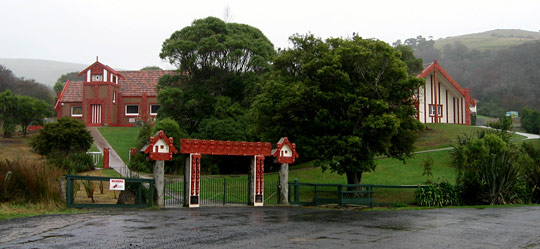Introduction
In this section you will discover what a marae is, what is involved when being welcomed onto a marae (and the different ways this can be done) and also be able to watch some video footage of a pōwhiri. You will learn about the difference between a pōwhiri and a mihi whakatau (and instances where one should be used instead of the other) and what kawa means. Nō reira, nau mai, haere mai, tauti mai ki tēnei Ao – welcome into this world!
What is a Marae?
Contrary to popular belief, a marae is not a meeting house, or at least not just a meeting house.
The term 'marae' refers to the entire complex made up of a Wharenui (meeting house, which may also be called a Whare Tīpuna, ancestral house, or Whare Rūnanga, communal meeting house), the Whare Kai (kitchen and dining hall) and Whare Paku (ablutions). Like Otākou Marae, on the Otago Peninsula, it may also include a Whare Karakia (Church) and urupā (burial ground, outside the marae grounds but associated with it).
The marae atea is the open meeting area in front of the wharenui, which in contemporary times, is a place where tikanga Māori (customs and protocols) are accorded their ultimate expression. This space – the marae atea – is the domain of Tūmatauenga (the Atua/Deity of 'man' and war), for this tends to be where the welcome ceremony, or pōwhiri, takes place. In traditional times, this was a time when the intentions of manuhiri (visitors) were tested, to ensure they came in peace rather than coming to confront, cause trouble or incite conflict; hence it being the realm of Tūmatuaenga.
Conversely, the domain of Rongo-mā-Tane (the Atua/Deity of peace, balance and cultivated foods) resides inside the wharenui. It is a place where, once the pōwhiri has been concluded, discussion, debate, deliberation, celebration and grief can freely occur in a peaceful, non-threatening manner (even though some heated debate and feisty dialogue can occur in the wharenui, a good outcome is always aspired to).

Otākou Marae , Otago Peninsula.
The building at the right is the Wharenui –Tamatea – and the building at the left is the
Otākou Memorial Methodist Church. Source
The wharenui represents a founding tīpuna (ancestor) from that hapū/iwi and is named as such (e.g. the wharenui at Otākou Marae is Tamatea; the wharenui at Huirapa Marae is Huirapa); as you enter into it, you are entering into the embodiment of an eponymous ancestor. Thus, it commands respect and strict adherence to tikanga and the kawa (localised tikanga) of the mana whenua (mana held by the people of that area).
If you take the time to look closely at the parts of the wharenui, you will notice the following:
- Tekoteko (head)
- Maihi (arms)
- Amo (legs)
- Tāhuhu (backbone)
- Heke (ribs)
- Poutokomanawa (central heart post)
Aside from the practical reason of maintaining cleanliness and hygiene, this is also the reason we tend to remove our shoes before entering into the body of this tīpuna, the wharenui (NOTE: this may be different from marae to marae, so take time to observe what others are doing before they enter. For example, on some Southern marae in Te waipounamu, shoes remain on when entering the Wharenui, for no other reason than it is too cold to remove them!) This is also the reason that no kai (food) is to be eaten inside the wharenui.
The marae remains the basis of community life, a place where many celebrations and functions continue to take place, such as:hapū (sub-tribal) and iwi (tribal) gatherings, birthdays, weddings, christenings, reunions, tangihanga (mourning ceremonies/funerals), kawe mate (memorial ceremonies), hura kohatu (unveilings), political meetings and religious/spiritual gatherings.
